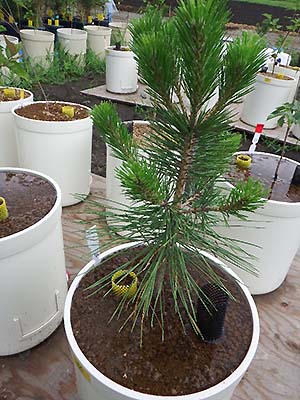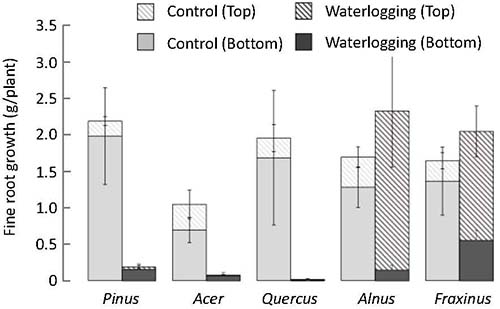Home > Research > Research Results > Research Results 2020 > Responses of tree roots to waterlogging stress are categorized into 3 types
Update:July 27, 2020
Main content starts here.
Responses of tree roots to waterlogging stress are categorized into 3 types
| Article title |
Root Responses of Five Japanese Afforestation Species to Waterlogging |
|---|---|
| Author (affiliation) |
Saki Fujita (a), Kyotaro Noguchi (b), Takeshi Tange (a) (a) The University of Tokyo, Bunkyo-ku, Tokyo, Japan. (b) Tohoku Research Center, FFPRI, Morioka, Iwate, Japan. |
| Publication Journal |
Forests, 11, 552, May 2020 DOI: 10.3390/f11050552( External link ) |
| Content introduction |
Water is an essential element for tree growth. However, when there is too much water, it can cause stress. In recent years, changes in rainfall patterns due to climate change have been predicted, and there is a possibility that the intensity and volume of precipitation events will increase in some areas. In such cases, waterlogging will frequently occur in forests and green areas that had already had poor drainage, and there is concern that this may lead to withering of trees due to such causes as roots rotting from lack of oxygen. However, we still do not have a good understanding about how tree roots respond to waterlogging stress. Therefore, in the present study, we examined saplings of 5 different tree species that are commonly found in green areas such as parks and coastal forests to learn how their roots responded to about 2.5 months of waterlogging stress (Photo). As a result, we found that the roots of 3 species (Pinus thunbergii, Acer mono and Quercus serrata) were vulnerable to stress because they stopped growing due to waterlogging (Figure), and some of the original roots withered and died. In contrast, the roots of the other 2 species (Alnus hirsuta and Fraxinus mandshurica), which commonly occur in marshlands, along streams, etc., continued to grow (Figure). A comparison of these last 2 species revealed that some of the original roots of A. hirsuta withered and died, while almost none of the roots of F. mandshurica did. Thus, it became clear that there are 3 types of responses of tree roots to waterlogging stress: (1) There is resistance to damage, and little effect on growth, (2) roots can grow but original roots become weak, and (3) there is no growth and original roots become weak. As a result, we can say that these findings will be able to provide important information for selecting appropriate tree species for planting in coastal areas and flatlands.
Photo:Scene from a waterlogging treatment experiment (Pinus thunbergii). The drainage holes in the pots were blocked with rubber stoppers, and water was repeatedly given every 1 to 3 days, depending on the weather and the water consumption of the saplings. Conditions were maintained so that the water table always reached the soil surface.
Figure:The amount of fine roots (per plant) that grew during the 2.5-month waterlogging treatment period. For each of the tree species, the left side shows normal conditions (control), while the right side shows the amount of fine roots that grew under waterlogged conditions. Almost none of the roots of 3 species (P. thunbergii, A. mono, and Q. serrata) could grow under waterlogged conditions. However, roots of the other two species (A. hirsuta and F. mandshurica) showed root growth under waterlogged conditions, especially in the topsoil (diagonally hatched lines, depth of 0-15cm) (This figure has been partially modified from the figure in the published paper). |
Copyright © Forest Research and Management Organization. All rights reserved.


